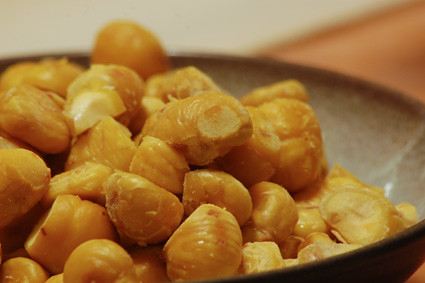Chestnut season is whenever I can get my hands on them, which isn't often. But Melissa surprised me - at her wedding reception, no less - with a bag full of fresh ones picked from her parents' yard. (I think.) I was a little slow to dealing with them, but now there are enough to enjoy with several meals.
They can be kind of a pain to peel, so I'm glad they're an at-most-once-a-year deal. I'm certain there's a more effective way to do this, but the traditional way is something like this:
Cut an X into each nut's flat (or flattest) side, pitching any with obvious insect damage.

Boil them for a few minutes, then leave sitting in the hot water as you peel them, one by one. The shells and skins remain flexible when warm, so you can tear them off with fingernails. Be ready for the occasional shell edge slipping under a thumbnail, which feels about as good as you might imagine. Be ready for raisinized fingertips. Be ready for tedium.
Then it's time to trim out any bad sections, insect larvae that've just been boiled to death, etc. This should leave you with a pile of sweet, golden nutmeats:

Now cook 'em, freeze 'em, or whatever. We added a handful to dinner, of course. One of my favorite uses is to add coarsely chopped chestnuts to polenta, added near the end of cooking so that they retain some texture. I didn't quite do that last night, but it was close. I had some fresh shell beans from the garden - the season's last - that I'd been meaning to use, and a big head of broccoli that Sharon had reserved for roasting.
An onion, diced, cooked in plenty of butter, with the beans added when they got soft and a bit brown. Some duck stock from a bird I'd turned into confit a week or two ago to braise the beans to tenderness, with more to enrich the polenta. (More butter and some Parmigiano do wonders for the polenta.) We had some fresh thyme, left over from curing this year's olives, so I added that, and the chestnuts, coarsely chopped, when the beans were coming near tender. The broccoli, after a toss with olive oil and salt, went in a hot oven until tender and a little brown. It's even better with cauliflower.
Top with a poached egg - since there isn't much that couldn't use one on top - and a light grating of cheese:

Perhaps the rest of the chestnuts'll have a repeat performance this weekend.
A pair of interesting chestnut facts:
- Chestnuts, being highly perishable, need to live in the fridge, and even then they don't last forever. But Harold McGee notes that freshly gathered chestnuts benefit from a few days at room temperature, during which time some of the starches convert to sugar.
- Alan Davidson points out that chestnut meal was the original ingredient in polenta, before the introduction of corn from the New World. Small, but flavorful - and free - wild chestnuts would have been the source, and were also used to stretch wheat and other flours in lean times.

2 comments:
Awesome. Brian, you should have a banner on your site that says "Warning : this post will make you hungry".
ooh I'm so glad you got good use our of your half! I SO should've roasted them at my parents' house, because, despite my anal-retentive inspection of every single chestnut for worm holes (about four times), I had worms out the wazoo. I only ended up taking about 20 back across the Atlantic, and even these bore worm damage once shelled. SO disappointing. I'll have to wait til the markets start stocking them here in a few weeks to get my fix.
Post a Comment